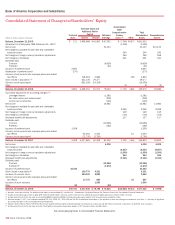Bank of America 2008 Annual Report Download - page 113
Download and view the complete annual report
Please find page 113 of the 2008 Bank of America annual report below. You can navigate through the pages in the report by either clicking on the pages listed below, or by using the keyword search tool below to find specific information within the annual report.Glossary
Assets in Custody – Consist largely of custodial and non-discretionary
trust assets administered for customers excluding brokerage assets.
Trust assets encompass a broad range of asset types including real
estate, private company ownership interest, personal property and
investments.
Assets Under Management (AUM) – The total market value of assets
under the investment advisory and discretion of Global Wealth and
Investment Management which generate asset management fees based
on a percentage of the assets’ market value. AUM reflects assets that
are generally managed for institutional, high net-worth and retail clients
and are distributed through various investment products including mutual
funds, other commingled vehicles and separate accounts.
Bridge Loan – A loan or security which is expected to be replaced by
permanent financing (debt or equity securities, loan syndication or asset
sales) prior to the maturity date of the loan. Bridge loans may include an
unfunded commitment, as well as funded amounts, and are generally
expected to be retired in one year or less.
CDO-Squared – A type of CDO where the underlying collateralizing secu-
rities include tranches of other CDOs.
Client Brokerage Assets – Include client assets which are held in broker-
age accounts. This includes non-discretionary brokerage and fee-based
assets which generate brokerage income and asset management fee
revenue.
Committed Credit Exposure – Includes any funded portion of a facility
plus the unfunded portion of a facility on which the Corporation is legally
bound to advance funds during a specified period under prescribed con-
ditions.
Core Net Interest Income – Managed Basis – Net interest income on a
fully taxable-equivalent basis excluding the impact of market-based activ-
ities and certain securitizations.
Credit Default Swaps (CDS) – A derivative contract that provides pro-
tection against the deterioration of credit quality and would allow one
party to receive payment in the event of default by a third party under a
borrowing arrangement.
Derivative – A contract or agreement whose value is derived from
changes in an underlying index such as interest rates, foreign exchange
rates or prices of securities. Derivatives utilized by the Corporation
include swaps, financial futures and forward settlement contracts, and
option contracts.
Excess Servicing Income – For certain assets that have been securitized,
interest income, fee revenue and recoveries in excess of interest paid to
the investors, gross credit losses and other trust expenses related to the
securitized receivables are all reclassified into excess servicing income,
which is a component of card income. Excess servicing income also
includes the changes in fair value of the Corporation’s card related
retained interests.
Home Equity Rapid Amortization Event – Certain events defined by the
Corporation’s home equity securitizations documents, including when
aggregate draws on monoline insurer’s policies (which protect the bond-
holders in the securitization) exceed a specified threshold. The existence
of a rapid amortization event affects the flow of funds and may cause
acceleration of payments to the holders of the notes.
Interest-only Strip – A residual interest in a securitization trust represent-
ing the right to receive future net cash flows from securitized assets after
payments to third party investors and net credit losses. These arise when
assets are transferred to a special purpose entity as part of an asset
securitization transaction qualifying for sale treatment under GAAP.
Interest Rate Lock Commitments (IRLCs) – Commitment with a loan
applicant in which the loan terms, including interest rate, are guaranteed
for a designated period of time subject to credit approval.
Letter of Credit – A document issued by the Corporation on behalf of a
customer to a third party promising to pay that third party upon pre-
sentation of specified documents. A letter of credit effectively substitutes
the Corporation’s credit for that of the Corporation’s customer.
Managed Basis – Managed basis assumes that securitized loans were
not sold and presents earnings on these loans in a manner similar to the
way loans that have not been sold (i.e., held loans) are presented. Non-
interest income, both on a held and managed basis, also includes the
impact of adjustments to the interest-only strip that are recorded in card
income.
Managed Net Losses – Represents net charge-offs on held loans com-
bined with realized credit losses associated with the securitized loan port-
folio.
Mortgage Servicing Right (MSR) – The right to service a mortgage loan
when the underlying loan is sold or securitized. Servicing includes collec-
tions for principal, interest and escrow payments from borrowers and
accounting for and remitting principal and interest payments to investors.
Net Interest Yield – Net interest income divided by average total interest-
earning assets.
Operating Basis – A basis of presentation not defined by GAAP that
excludes merger and restructuring charges.
Option-Adjusted Spread (OAS) – The spread that is added to the discount
rate so that the sum of the discounted cash flows equals the market
price, thus, it is a measure of the extra yield over the reference discount
factor (i.e., the forward swap curve) that a company is expected to earn
by holding the asset.
Qualified Special Purpose Entity (QSPE) – A special purpose entity
whose activities are strictly limited to holding and servicing financial
assets and meet the requirements set forth in SFAS 140. A qualified
special purpose entity is generally not required to be consolidated by any
party.
Return on Average Common Shareholders’ Equity (ROE) – Measures the
earnings contribution of a unit as a percentage of the shareholders’
equity allocated to that unit.
Return on Average Tangible Shareholders’ Equity (ROTE) – Measures
the earnings contribution of a unit as a percentage of the shareholders’
equity allocated to that unit reduced by allocated goodwill and intangible
assets (excluding MSRs).
Securitize / Securitization – A process by which financial assets are sold
to a special purpose entity, which then issues securities collateralized by
those underlying assets, and the return on the securities issued is based
on the principal and interest cash flow of the underlying assets.
SOP 03-3 Portfolio – Loans acquired from Countrywide which showed
signs of deterioration and were considered impaired. These loans were
written down to fair value at the acquisition date in accordance with SOP
03-3.
Structured Investment Vehicle (SIV) – An entity that issues short dura-
tion debt and uses the proceeds from the issuance to purchase longer-
term fixed income securities.
Subprime Loans – Although a standard definition for subprime loans
(including subprime mortgage loans) does not exist, the Corporation
defines subprime loans as specific product offerings for higher risk bor-
rowers, including individuals with one or a combination of high credit risk
factors, such as low FICO scores (generally less than 620 for secured
products and 660 for unsecured products), high debt to income ratios
and inferior payment history.
Bank of America 2008
111
























